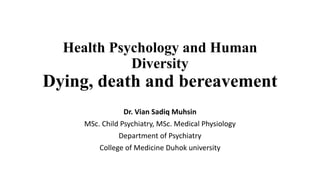
revised bereavement.pptx
- 1. Health Psychology and Human Diversity Dying, death and bereavement Dr. Vian Sadiq Muhsin MSc. Child Psychiatry, MSc. Medical Physiology Department of Psychiatry College of Medicine Duhok university
- 2. Learning Objectives This lecture points to: *Discuss bereavement; recognize the varied responses of individuals. *The 5 stage Grief model *Clinical symptoms to bereavements *Consider the reactions of health professionals to working with dying patient. * Good Death
- 3. Death , grief, bereavement • Death: is - a permanent cessation of all vital functions : the end of life. Is the permanent cessation of all biological functions that sustain a living organism. • Grief : sadness. Is the response to loss. • Bereavement: Is a big catastrophe like death, loss.. Is being deprived of a relative, loved one or friend, esp. by death.
- 4. Diversity in death: 1- Gender Gender: – Women on average live longer – UK life expectancy at birth (2009-2011) • Men 78.7 • Women 82.6
- 5. Diversity in death: 2- Age • Death rates highest in older age groups • 2010: 67 per cent of deaths were people age 75+ • But people can die at any age • Death of child / young person can be particularly difficult to cope with
- 6. Diversity in death: 3- socioeconomic differences • Socioeconomic status: – Less wealthy on average experience poorer health and die sooner
- 7. Diversity in dying 1. Gradual death with a slow decline in ability and health 2. Catastrophic death through sudden and unexpected events 3. Premature death in children and young adults through accidents or illness
- 8. Initial reactions to news of terminal illness • Most people experience shock, numbness, disbelief and confusion.
- 9. Coping with a terminal illness 1. Shock 2. fear 3. anger 4. resentment (feeling of disagreement or non acceptance) 5. denial 6. helplessness 7. sadness 8. frustration 9. relief 10.acceptance
- 10. Adjusting to the idea of dying: The 5 stage Grief model (Kübler-Ross 1969) 1• Denial 2• Anger 3• Bargaining 4• Depression 5• Acceptance
- 11. The 5 stage Grief model 1. Denial: blocking external events from awareness. e.g. • refusal to discuss illness • it’s not true • it can’t be happening to me. • Can be a coping mechanism. • – “it’s not true” “it can’t be happening to me”
- 12. The 5 stage Grief model 2. Anger: – “why me?” – Who is to blame? “the doctors don’t know what they are doing” – Search for alternatives? 3. Bargaining: Bargaining: ways to avoid having the bad thing happen. Bargaining is vain expression of hope that the bad news is reversible. e.g. I’ll go to mosque every day if I can just live to see my grandchild”?
- 13. The 5 stage Grief model 4. Depression: – “what’s the point?” “I can’t fight any longer” (low or depress mood, loss of energy, loss of interest, disturbance of sleep and appetite). 5. Acceptance: where the person is ready and actively involved in moving on to the next phase of their lives, no matter how short (– “It will be OK” “I’m ready to make funeral arrangements”)
- 14. The grieving process • Each person experiences stages differently – BUT reassuring for people to know that grief passes through various stages and for most people grief will lessen and end
- 15. Bereavement Clinical symptoms: • Physical e.g. shortness of breath & palpitations; fatigue; digestive symptoms; reduced immune function. • Behavioral: e.g. insomnia, irritability, crying, social withdrawal • Emotional: e.g. depression, anxiety, anger, guilt, loneliness • Cognitive: e.g. lack of concentration, memory loss, hopelessness, disturbance of identity, visual and auditory hallucinations
- 16. Bereavement & grief Prognosis • Within 2 years – 85% adjusted to bereavement & experiencing minimal grief – 15% experiencing chronic grief: anxiety, depression, PTSD • *“there is no way around grief, only a way through” Collick (1986)
- 17. Risk factors for chronic grief 1. Prior bereavements, 2. Psychiatric illnesses . 3. Type of loss (young person, nature of death). 4. Lack of social support. 5. Presence of stress from other crises. Factors that lead to complications in grief process 1. Expression of grief discouraged 2. Ending of grief discouraged
- 18. Palliative care to terminal illness • Improve quality of life • Manage emotional and physical symptoms • Support patients to live productively • Good death
- 19. GOOD DEATH .
- 20. Death of a patient • Death should never be ‘routine’ but more likely to seriously impact on health of professional when the patient is well known or likes us or likes someone we are close to • Feelings? • Failure, sadness, guilt, anger, • Reminder of mortality or own personal loss • Is it right to express emotions when you are the doctor? • Coping • need to protect yourself, but important not to lose empathy
- 21. Summary • There is a great deal of diversity in death • Individuals have different patterns of adjusting to the idea of dying • Grief in response to bereavement has common patterns, but there are large individual differences in experience • Doctors play an important role in helping patients to have a ‘good death’ • Doctors need to reflect on their own reactions to dying and death